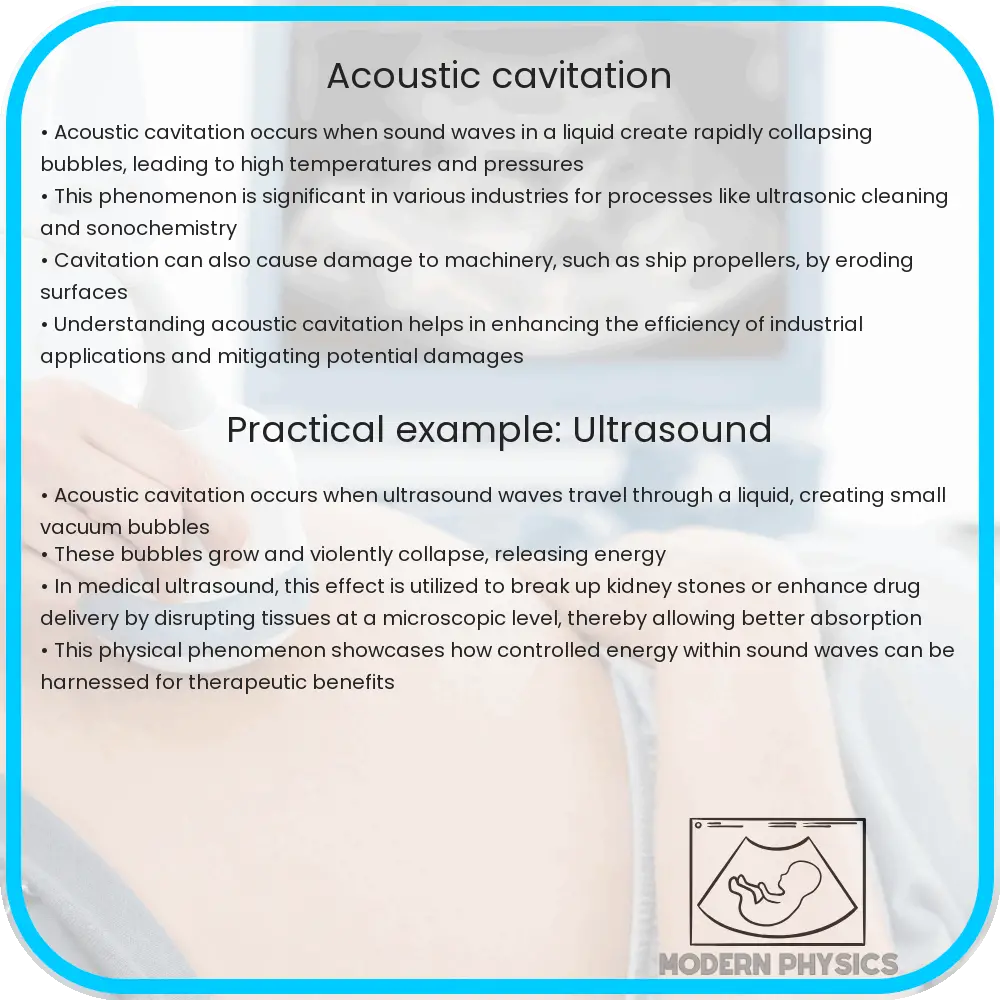Learn how acoustic cavitation forms when sound waves create vapor bubbles in liquids, leading to powerful effects used in cleaning and medical applications.

Understanding Acoustic Cavitation
Acoustic cavitation is a fascinating phenomenon that occurs when sound waves travel through a liquid. This process can create small vapor-filled cavities or bubbles in the liquid, which form and collapse rapidly, releasing significant energy. The dynamics of these bubbles are primarily influenced by the properties of the liquid and the frequency and intensity of the sound waves.
The Physics Behind Acoustic Cavitation
At the core of acoustic cavitation is the behavior of sound waves as they propagate through a medium. Sound waves are essentially pressure waves, and when these waves pass through a liquid, they cause the liquid molecules to move in a repetitive cycle of compression (where molecules are pushed together) and rarefaction (where molecules are pulled apart). During rarefaction, if the local pressure falls below the vapor pressure of the liquid, small vapor bubbles can form. If the pressure is quickly raised during the compression phase, these bubbles collapse violently.
The collapse of these bubbles is a highly energetic event. When a bubble collapses, it generates shock waves that propagate through the liquid and can cause significant physical effects, such as light emission (sonoluminescence), high temperatures, and strong forces. The latter are particularly useful in applications like ultrasonic cleaning.
Ultrasonic Cleaning: Applications of Acoustic Cavitation
One of the most common applications of acoustic cavitation is in ultrasonic cleaning. This technique uses cavitation generated by high frequency sound waves (usually in the range of 20 kHz to 400 kHz) to clean items. The process involves submerging the items to be cleaned in a fluid and then subjecting them to high-intensity ultrasonic waves.
The microscopic bubbles generated during acoustic cavitation, when they collapse near the surface of the item, produce intense local shockwaves that dislodge contaminants such as dirt, oil, grease, and other types of grime. This method is highly effective for cleaning complex geometric surfaces where traditional cleaning methods may fail to reach.
- Efficiency: Ultrasonic cleaning is known for its efficiency and ability to clean delicate and intricate parts without causing damage.
- Environmental Safety: It mostly uses water or mild solvents, reducing the need for harsh chemicals.
- Versatility: It is used in various industries, including medical, automotive, and electronics, to name a few.
This combination of effectiveness, safety, and versatility makes ultrasonic cleaning a preferred choice in many professional and industrial settings.
Further Applications of Acoustic Cavitation
Beyond cleaning, acoustic cavitation has interesting applications in areas like sonochemistry, where it is used to accelerate chemical reactions. It can also be found in medical therapies, particularly in the breaking up of kidney stones and targeted drug delivery systems. Each of these applications leverages the intense energy released by the collapsing bubbles to achieve distinct results, from facilitating chemical reactions to breaking apart solid materials inside the body.
The ability to generate and control cavitation has significant industrial and medical applications, making the study of acoustic cavitation crucial in both engineering and physics.
Control and Challenges in Acoustic Cavitation
Although acoustic cavitation is useful in many applications, controlling the process effectively presents challenges. The primary difficulty lies in managing the intensity and distribution of cavitation to maximize effectiveness while minimizing potential damage. This involves precise calibration of frequency and power output based on the properties of the liquid and the application’s specific requirements.
Moreover, excessive cavitation can lead to unintended erosion or wear on equipment, such as the degradation of ultrasonic cleaning tanks over time. Engineers must design equipment that can withstand the stresses of repeated cavitation cycles while maintaining optimal performance.
Future Prospects of Acoustic Cavitation
The ongoing research into acoustic cavitation is expanding its possible applications and improving existing technologies. Advances in computational fluid dynamics and materials science are playing a crucial role in understanding and harnessing this phenomenon more effectively. As we continue to refine these approaches, the potential for new or enhanced applications in cleaning, medicine, and chemistry is enormous.
- Innovative Cleaning Solutions: Research aims to make ultrasonic cleaning even more effective and adaptable to different materials.
- Medical Advancements: Further development in non-invasive surgery techniques and targeted therapies could transform patient care.
- Enhanced Chemical Processing: Improvements in sonochemistry may lead to more efficient and environmentally-friendly industrial processes.
Conclusion
Acoustic cavitation represents a remarkable intersection of physics and engineering, illustrating how principles derived from fundamental science can be leveraged to solve practical, real-world problems. From the high-tech industrial applications in cleaning and material processing to critical medical therapies, the control of this powerful phenomenon harnesses incredible benefits. While there are challenges in managing cavitative forces without inducing damage, ongoing research and technological innovations continue to broaden its applications and efficiency. Embracing both the complexities and opportunities of acoustic cavitation helps drive advancements in numerous scientific and industrial fields, promising exciting developments for the future.
